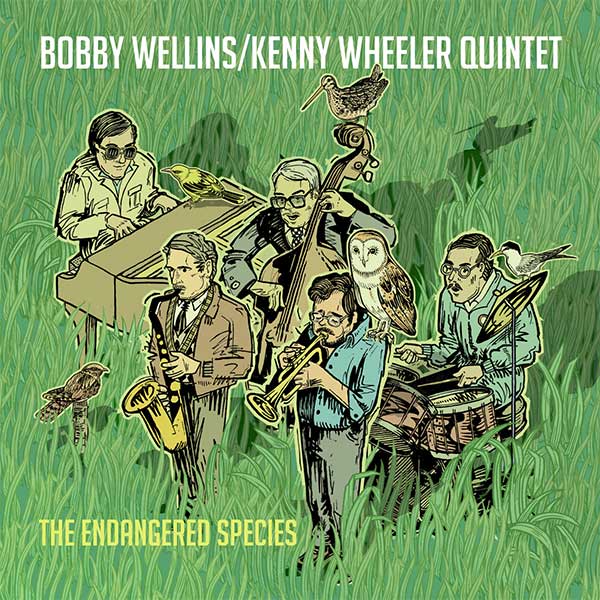
The Endangered Species, Bobby Wellins / Kenny Wheeler Quartet
(3-CD set / Digital Album, Jazz in Britain)
In 1980, Bobby Wellins was commissioned by South East Arts to write a jazz suite. He was told he could write what he liked but they’d prefer, as Wellins himself put it, something ‘pertaining to the South Coat of England, where I live.’ What he wrote, The Endangered Species, was a response to the devastating effect an oil-spill at Bognor Regis – where he lived – had had on the local population of guillemots. The suite was taken on tour in 1982 and, with added string arrangements, issued as an album in 1989. For the album, the title was changed to The Birds of Brazil. Jazz in Britain has recently released the original, without the arrangements, packaged with a number of tunes that were played on the original tour, along with a useful twenty-four page booklet. Not only that, but they’ve included three separately recorded versions of the suite.
In the booklet, the drummer, Spike Wells, explains how Wellins gave the name of an endangered bird species to each of the instruments: snipe to the bass, nightjar to the sax, little tern to the drums and golden oriole to the piano. Each part of the suite is named after the bird that goes with the instrument that takes a lead in it.
The first movement features an extended bass solo and is, in places, evocative of the sea in that elusive way composers have which goes right back to Debussy and La Mer. When you hear it, in films or, say, Benjamin Britten’s Four Sea Interludes, you wonder if there’s a trick to it: something to do with the way you sustain added-note chords, mimic the swell of the sea or capture the elusive quality of its surface. If there were a composer’s stock-library, there would be a whole section devoted to sea-gestures. For example, the alternating major thirds at the start recall those at the beginning of Britten’s second Interlude. Why they should evoke the sea, I don’t know, but they do. The first part of the third movement has something of that feel, too. Overall, the music, for all its energy, drama and virtuosity, has something of the mood of a lament.
As well as being a great listen, it’s an interesting piece of history, a pin on a chart tracing the historical changes in public concern for the environment and the planet. A lot of ideas around today were around then: in the 1970s, PEOPLE, the forerunner of the Ecology Party, later to become the Green Party, were already talking about the need for zero growth. However, it’s probably true to say what was happening was still seen by a lot of people as a series of crises – the guillemots of Bognor Regis being a case in point – rather than a major, overarching problem. Things have changed. The chatter of the chattering classes today is less likely to focus on an isolated case and more likely to revolve around the catastrophic demise of seabirds generally (a reliable study has identified a seventy percent decline in world seabird populations over the past seventy-five years), microplastic pollution, shit in rivers, insect decline and the political paralysis that has prevented us from heading off catastrophic climate change. And fewer people these days buy into the myth that we’re somehow stewards of the planet: there is a more widespread (if woefully belated) understanding that we’re just one species among many, all stuck on the same, finite space-rock as the guillemots of Bognor Regis.
At first, I wondered if including three versions of the suite was overkill, but on listening decided it was actually great to have them all. The third is actually introduced by Wellins himself. The overwhelming majority of the album – as one would expect – was professionally recorded, but my favourite version is probably the one on Disc 2, which was recorded live, as the album booklet puts it, ‘by Spike Wells on his trusty ghetto blaster’. It goes on to say they’ve cleaned it up as best they can: I must say they’ve done a good job and any quality issues are well outweighed by the immediacy that goes with a cracking live performance. Indeed, the manner of its recording captures some of the magic of actually being there. Ambience aside, it also includes an inspired piano solo from Pete Jacobsen, which was, for me, one of the highlights of the album (it’s just over twenty-one minutes in). Spike Wells’ drum solo on the Disc 1 version is a great listen, too. All in all, The Endangered Species is a pretty special album. And its good to know that all the birds it celebrates (there’s an update at the end of the booklet), despite suffering ups and downs over the past forty-five years, are still with us.
.
Dominic Rivron
LINK
The Endangered Species: https://jazzinbritain1.bandcamp.com/album/the-endangered-species
.
